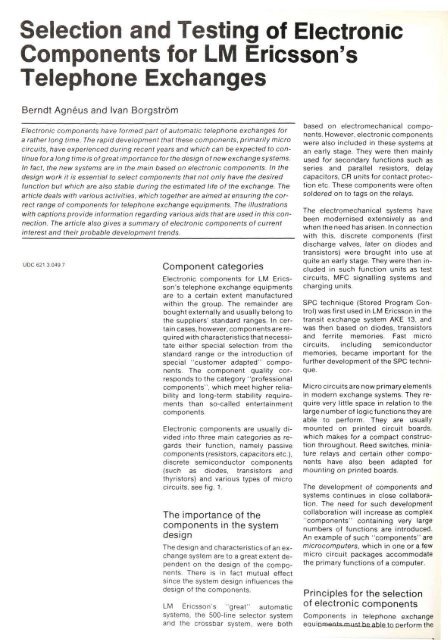Selection and Testing of Electronic Components for LM
Selection and Testing of Electronic Components for LM
Selection and Testing of Electronic Components for LM
You also want an ePaper? Increase the reach of your titles
YUMPU automatically turns print PDFs into web optimized ePapers that Google loves.
<strong>Selection</strong> <strong>and</strong> <strong>Testing</strong> <strong>of</strong> <strong>Electronic</strong><br />
<strong>Components</strong> <strong>for</strong> <strong>LM</strong> Ericsson's<br />
Telephone Exchanges<br />
Berndt Agneus <strong>and</strong> Ivan Borgstrom<br />
<strong>Electronic</strong> components have <strong>for</strong>med part <strong>of</strong> automatic telephone exchanges <strong>for</strong><br />
a rather long time. The rapid development that these components, primarily micro<br />
circuits, have experienced during recent years <strong>and</strong> which can be expected to continue<br />
<strong>for</strong> a long time is <strong>of</strong> great importance <strong>for</strong> the design <strong>of</strong> new exchange systems.<br />
In fact, the new systems are in the main based on electronic components. In the<br />
design work it is essential to select components that not only have the desired<br />
function but which are also stable during the estimated life <strong>of</strong> the exchange. The<br />
article deals with various activities, which together are aimed at ensuring the correct<br />
range <strong>of</strong> components <strong>for</strong> telephone exchange equipments. The illustrations<br />
with captions provide in<strong>for</strong>mation regarding various aids that are used in this connection.<br />
The article also gives a summary <strong>of</strong> electronic components <strong>of</strong> current<br />
interest <strong>and</strong> their probable development trends.<br />
UDC 621.3.049.7 Component categories<br />
<strong>Electronic</strong> components <strong>for</strong> <strong>LM</strong> Ericsson's<br />
telephone exchange equipments<br />
are to a certain extent manufactured<br />
within the group. The remainder are<br />
bought externally <strong>and</strong> usually belong to<br />
the suppliers' st<strong>and</strong>ard ranges. In certain<br />
cases, however, components are required<br />
with characteristics that necessitate<br />
either special selection from the<br />
st<strong>and</strong>ard range or the introduction <strong>of</strong><br />
special "customer adapted" components.<br />
The component quality corresponds<br />
to the category "pr<strong>of</strong>essional<br />
components", which meet higher reliability<br />
<strong>and</strong> long-term stability requirements<br />
than so-called entertainment<br />
components.<br />
<strong>Electronic</strong> components are usually divided<br />
into three main categories as regards<br />
their function, namely passive<br />
components (resistors, capacitors etc.),<br />
discrete semiconductor components<br />
(such as diodes, transistors <strong>and</strong><br />
thyristors) <strong>and</strong> various types <strong>of</strong> micro<br />
circuits, see fig. 1.<br />
The importance <strong>of</strong> the<br />
components in the system<br />
design<br />
The design <strong>and</strong> characteristics <strong>of</strong> an exchange<br />
system are to a great extent dependent<br />
on the design <strong>of</strong> the components.<br />
There is in fact mutual effect<br />
since the system design influences the<br />
design <strong>of</strong> the components.<br />
<strong>LM</strong> Ericsson's "great" automatic<br />
systems, the 500-line selector system<br />
<strong>and</strong> the crossbar system, were both<br />
based on electromechanical components.<br />
However, electronic components<br />
were also included in these systems at<br />
an early stage. They were then mainly<br />
used <strong>for</strong> secondary functions such as<br />
series <strong>and</strong> parallel resistors, delay<br />
capacitors, CR units <strong>for</strong> contact protection<br />
etc. These components were <strong>of</strong>ten<br />
soldered on to tags on the relays.<br />
The electromechanical systems have<br />
been modernised extensively as <strong>and</strong><br />
when the need has arisen. In connection<br />
with this, discrete components (first<br />
discharge valves, later on diodes <strong>and</strong><br />
transistors) were brought into use at<br />
quite an early stage. They were then included<br />
in such function units as test<br />
circuits, MFC signalling systems <strong>and</strong><br />
charging units.<br />
SPC technique (Stored Program Control)<br />
was first used in <strong>LM</strong> Ericsson in the<br />
transit exchange system AKE 13, <strong>and</strong><br />
was then based on diodes, transistors<br />
<strong>and</strong> ferrite memories. Fast micro<br />
circuits, including semiconductor<br />
memories, became important <strong>for</strong> the<br />
further development <strong>of</strong> the SPC technique.<br />
Micro circuits are now primary elements<br />
in modern exchange systems. They require<br />
very little space in relation to the<br />
large number <strong>of</strong> logic functions they are<br />
able to per<strong>for</strong>m. They are usually<br />
mounted on printed circuit boards,<br />
which makes <strong>for</strong> a compact construction<br />
throughout. Reed switches, miniature<br />
relays <strong>and</strong> certain other components<br />
have also been adapted <strong>for</strong><br />
mounting on printed boards.<br />
The development <strong>of</strong> components <strong>and</strong><br />
systems continues in close collaboration.<br />
The need <strong>for</strong> such development<br />
collaboration will increase as complex<br />
"components" containing very large<br />
numbers <strong>of</strong> functions are introduced.<br />
An example <strong>of</strong> such "components" are<br />
microcomputers, which in one or a few<br />
micro circuit packages accommodate<br />
the primary functions <strong>of</strong> a computer.<br />
Principles <strong>for</strong> the selection<br />
<strong>of</strong> electronic components<br />
<strong>Components</strong> in telephone exchange<br />
eauiartiants musLhe_abJe to per<strong>for</strong>m the
















